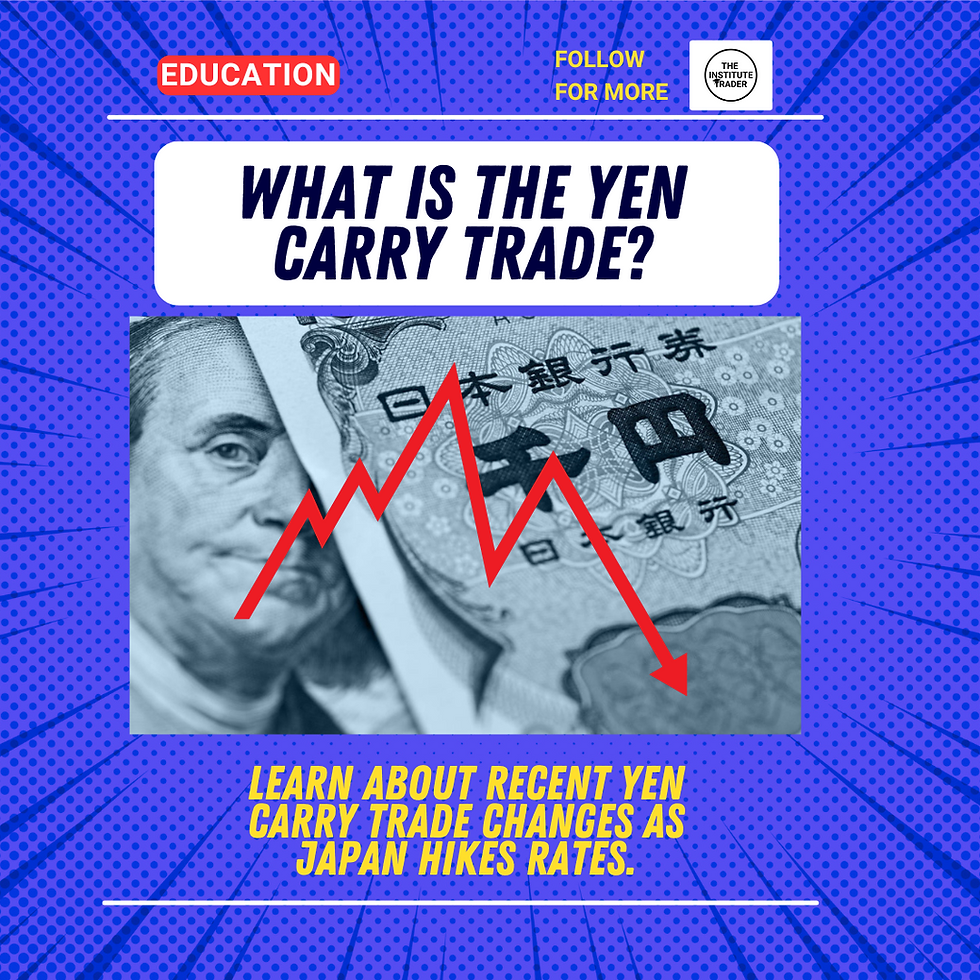What is the Yen Carry Trade?
- The Institute Trader

- Aug 7, 2024
- 3 min read

Simple Explanation of the Yen Carry Trade
A carry trade is where investors have borrowed money from economies with low interest rates such as Japan or Switzerland, to fund investments in higher-yielding assets elsewhere.
For numerous years, the BOJ has maintained low interest rates, which has led to a gradual increase in the scale of the Yen Carry trade undertaken by institutional banks, hedge funds, and other entities.
For the first time in many years the BOJ increased interest rates on March 19 2024 by 0.25%. This was almost unprecedented and as a result the carry trade begun to unwind as the USD/YEN dropped significantly.
There are estimates the dollar-yen carry trade grew to at least $500 billion at its peak and that the unwinding so far could be calculated to about $200 billion of being unwound over the last two to three weeks.
The unwinding of the yen carry trade is happening quickly, similar to the rapid reversal seen in 2007 during the sub-prime mortgage crisis. Analysis across the market indicates that fears of a US economic slowdown are the primary catalyst for this shift and along with the recent rate hikes noted. The reality is that alot of money was caught out of position and has to do something about it.
Future movements of the yen will likely hinge on the US economic outlook and the FED's policy response. While exact data on the yen carry trade — where investors borrow yen to invest in higher-yielding foreign assets — is sparse, we can deduce its scale, key participants, and potential for further unwinding.
1. Size: 2024 Mirrors 2007
While the exact size of the yen carry trade remains unknown, yen short positions are a dependable indicator. The existing short positions indicate that speculative selling of the yen is currently as prevalent as it was prior to the collapse of the carry trade in 2007.
2. Factors Influencing the Carry Trade
In the mid-2000s, a significant portion of the carry trade was linked to foreign banks in Japan obtaining the yen and transferring it to their main offices. However, the current situation seems to have changed. Recent data indicates that short-selling activities by foreign banks have been approximately half of what they were in 2007. This suggests that other non-commercial traders, like macro hedge funds, are now taking on a more prominent role.
3. US as a Primary Investment Destination
Tracking the final investment destinations of yen-borrowed funds is challenging. However, Japan’s balance of payments data indicates a notable increase in Japanese portfolio investments in US assets compared to other regions. Some of this capital might be funneled into higher-yielding emerging markets, although the visibility is lacking in these secondary investments.
Should a significant portion of this carry trade be allocated to US assets, additional unwinding may continue to impact the US markets even more.
Wrapping Up
The Japanese Yen's recent rally and the potential unwinding of the carry trade are pivotal developments in the financial markets. Japanese officials have tried to restore calm after the past couple of days assuring that they will be keeping a close eye the market .Consequently, Investors must stay informed and be prepared for further volatility. As always, understanding the underlying factors and potential catalysts will be key to navigating these turbulent times.
FAQs
1. What is the carry trade? The carry trade involves borrowing in a low-interest currency, like the Yen, and investing in higher-yielding assets. It's a popular strategy due to the interest rate differential.
2. Why is the Japanese Yen rallying? The Yen's rally is driven by the Bank of Japan's recent hawkish shift in monetary policy and market speculation about the potential unwinding of the carry trade.
3. What should investors watch for next? Investors should monitor the Bank of Japan's future actions, U.S. economic data, and any signs of further shifts in the foreign exchange market.
4. How does the carry trade impact the market? The carry trade can influence various asset classes, including currencies, stocks, and bonds. A significant unwinding of the carry trade can lead to increased volatility and shifts in market dynamics.
Disclaimer:
The information provided in this article is for general informational purposes only. It is not intended to be financial advice and should not be construed as such. Always consult with a qualified financial advisor before making any investment decisions. The author and publisher are not liable for any financial losses or damages that may result from the use of this information.







